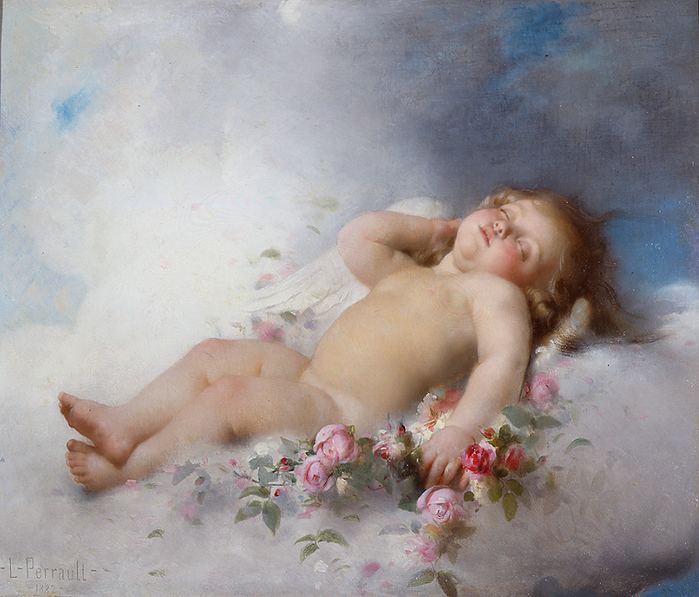 | ||
A putto ([ˈputto]; plural putti [ˈputti] or puttoes) is a figure in a work of art depicted as a chubby male child, usually naked and sometimes winged. A putto is often called a cherub (plural cherubs) although unlike the Biblical cherub (plural cherubim) in form and symbolism: cherubim have four faces of different species and several pairs of wings, and are sacred, whereas putti are secular and represent a non-religious passion. However, in the Baroque period of art, the putto came to represent the omnipresence of God. A putto representing a cupid is also called an amorino (plural amorini).
Contents
Etymology
The more commonly found form putti is the plural of the Italian word putto. The Italian word comes from the Latin word putus, meaning "boy" or "child". Today, in Italian, putto means either toddler winged angel or, rarely, toddler boy. It may have been derived from the same Indo-European root as the Sanskrit word "putra" (meaning "boy child", as opposed to "son"), Avestan puθra-, Old Persian puça-, Pahlavi (Middle Persian) pus and pusar, all meaning "son", and the New Persian pesar "boy, son".
Putti, in the ancient classical world of art, were winged infants that were believed to influence human lives. In Renaissance art, the form of the putto was derived in various ways including the Greek Eros or Roman Amor/Cupid, the god of love and companion of Aphrodite or Venus; the Roman, genius, a type of guardian spirit; or sometimes the Greek, daemon, a type of messenger spirit, being halfway between the realms of the human and the divine.
Revival of the putto in the Renaissance
Putti are a classical motif found primarily on child sarcophagi of the 2nd century, where they are depicted fighting, dancing, participating in bacchic rites, playing sports, etc.
During the Middle Ages, the putto disappeared and was revived during the Quattrocento.The revival of the figure of the putto is generally attributed to Donatello, in Florence in the 1420s, although there are some earlier manifestations (for example the tomb of Ilaria del Carretto, sculpted by Jacopo della Quercia in Lucca). Since then, Donatello has been called the originator of the putto because of the contribution to art he made in restoring the classical form of putto. He gave putto a distinct character by infusing the form with Christian meanings and using it in new contexts such as musician angels. Putti also began to feature in works showing figures from classical mythology, which became popular in the same period.
Most Renaissance putti are essentially decorative and they ornament both religious and secular works, without usually taking any actual part in the events depicted in narrative paintings. There are two popular forms of the putto as the main subject of a work of art in 16th-century Italian Renaissance art: the sleeping putto and the standing putto with an animal or other object.
Where putti are found
Putti, cupids, and angels (see below) can be found in both religious and secular art from the 1420s in Italy, the turn of the 16th century in the Netherlands and Germany, the Mannerist period and late Renaissance in France, and throughout Baroque ceiling frescoes. So many artists have depicted them that a list would be pointless, but among the best-known are the sculptor Donatello and the painter Raphael. The two relaxed and curious putti who appear at the foot of Raphael's Sistine Madonna are often reproduced.
They also experienced a major revival in the 19th century, where they gamboled through paintings by French academic painters, from Gustave Doré’s illustrations for Orlando Furioso to advertisements.
Iconography of the putto
The iconography of putti is deliberately unfixed, so that it is difficult to tell the difference between putti, cupids, and various forms of angels. They have no unique, immediately identifiable attributes, so that putti may have many meanings and roles in the context of art.
Some of the more common associations are:
Putti in popular culture
A putto is the main character in the 2010 webcomic The Sorrowful Putto of Prague by James Stafford and A. J. Bernardo.
In popular culture, putto is also used as a decorative art found on buildings, gardens, and greeting cards as a purveyor of love.
A putto smoking a cigarette served as the cover art for Van Halen's album 1984 .
A putto is the protagonist of the 2000 third person shooter Messiah.
In the British TV series Doctor Who, infants of the species Weeping Angels appear as putti.
In the 1st-person shooter Team Fortress 2, the Meet the Pyro video has the BLU Team appear as putti in Pyroland (The Pyro's vision).
In the 2003 video game Drakengard, a group of malevolent god-like figures known as the Watchers appear as putti.
Historiography
The historiography of this subject matter is very short. Many art historians have commented on the importance of the putto in art, but few have undertaken a major study. One useful scholarly examination is Charles Dempsey's Inventing the Renaissance Putto.
